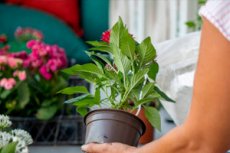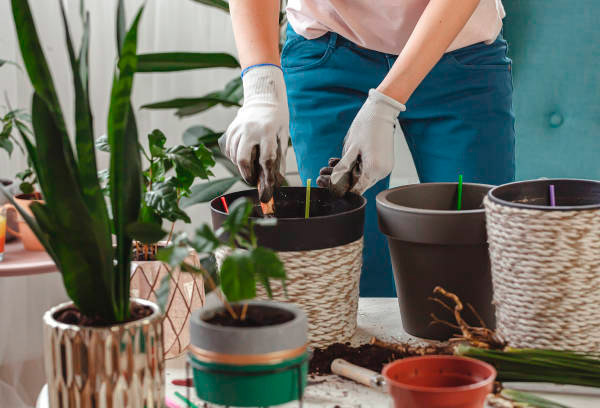How to choose the perfect pot for your plant?
Last reviewed: 11.03.2025

Choosing the right pot for houseplants is a key factor that influences their health and thriving. The ideal pot provides optimal conditions for the root system, promotes effective nutrient absorption, and prevents problems related to overwatering or drying out the soil. In this article, we will discuss the main criteria for selecting pots, including size, material, and drainage, as well as provide practical tips for ensuring the health of your plants.
Pot size
The correct pot size plays an important role in plant development. A pot that is too small can restrict root growth, cause stress to the plant, and reduce its vitality. On the other hand, a pot that is too large can lead to excessive soil moisture, promoting root rot and the development of fungal diseases.
Key aspects when choosing the pot size:
- Pot diameter:
- It is recommended to choose a pot that exceeds the current root size by 2-5 cm in diameter.
- For young plants, it’s better to use smaller pots, gradually moving to larger ones as they grow.
- Pot depth:
- Deep plants, such as ficus or bamboo, require deeper pots to provide enough space for root development.
- Shallow plants, like cacti or succulents, can be placed in less deep pots.
- Pot capacity:
- The pot's volume should meet the plant’s need for nutrients and water.
- Consider the plant’s growth rate and plan for transplanting in advance.

Pot material
The material from which the pot is made affects several aspects, including ventilation, soil temperature, water retention capacity, and appearance. Let’s consider the main materials and their characteristics:
- Clay (terracotta):
- Advantages: Breathable material provides good root ventilation, prevents soil overwatering, natural appearance.
- Disadvantages: Heavy and fragile, may break when dropped, prone to drying out in hot conditions.
- Ceramic:
- Advantages: Variety of designs and colors, durability, resistance to mechanical damage.
- Disadvantages: Heavier and more expensive than other materials, may require additional protection from damage.
- Plastic:
- Advantages: Lightweight, inexpensive, variety of shapes and colors, often with built-in drainage holes.
- Disadvantages: Less eco-friendly, can retain heat, which may lead to soil overheating in sunny conditions.
- Expanded clay and hydroponic materials:
- Advantages: Ideal for hydroponics and self-watering systems, provides excellent aeration for roots.
- Disadvantages: Requires special preparation and care, not always suitable for traditional planting.
- Metal:
- Advantages: Stylish and modern appearance, durability.
- Disadvantages: Thermal conductivity can lead to soil overheating, potential for corrosion, especially when using aggressive fertilizers.
Drainage in the pot
Having drainage holes in the pot is critically important for plant health. Drainage prevents water from stagnating in the soil, which reduces the risk of root rot and fungal diseases.
Key aspects of drainage:
- Drainage Holes:
- Make sure the pot has enough holes at the bottom for excess water to drain freely.
- When choosing a pot without holes, use a drainage layer of expanded clay or gravel at the bottom of the container.
- Tray:
- Using a tray helps collect excess water and prevents floor damage.
- Regularly empty the tray to prevent water from stagnating.
- Soil Aeration:
- Good soil aeration promotes root health and prevents harmful microorganisms from developing.
Practical tips for choosing a pot
- Consider the plant's needs:
- Different plant species have different requirements for pot size and material. For example, cacti and succulents prefer shallow, well-drained pots, while ficus and bamboo plants need deeper containers.
- Plan for transplanting:
- Choose a pot with enough size margin to avoid frequent repotting. Typically, repotting is done every one or two years, depending on the plant’s growth.
- Design and aesthetics:
- The pot should complement the room’s interior. Choose a pot’s color and shape that suits the overall style of your home.
- Environmental considerations:
- When selecting the pot material, consider its environmental safety and the possibility of reuse or recycling.
- Functionality:
- Some pots come with additional features, such as built-in self-watering systems, which simplify plant care.
Impact of pot selection on plant health
Choosing the right pot directly affects plant health and growth. Inadequate size or poor material can lead to slow growth, nutrient deficiencies, and increased vulnerability to diseases. A well-selected pot provides optimal conditions for root development, improves air circulation, and promotes efficient water and nutrient absorption.
Conclusion
Choosing the ideal pot for houseplants is an important step in creating a healthy and thriving home garden. By considering size, material, and drainage, you can provide your plants with the best conditions for growth and development. Following the above tips will help you choose a pot that is not only functional but also aesthetically pleasing, harmonizing with the interior of your home. Remember, the health of your plants depends not only on the pot but also on proper care, so pay attention to all aspects of plant care.
Frequently Asked Questions (FAQ)
What material is best suited for pots for indoor plants?
Answer: The choice of pot material depends on the type of plant and the growing conditions. The following materials are popular for indoor plants:
- Clay (Terracotta): Allows the soil to "breathe," preventing overwatering of roots. However, they can be heavy and easily breakable.
- Ceramics: Aesthetic and available in various designs. Usually glazed, which reduces porosity but can retain moisture.
- Plastic: Lightweight, inexpensive, and durable. Do not allow air passage, so good drainage is important.
- Metal: Stylish but can heat up in the sun, causing root overheating.
- Textile Pots: Provide good aeration for roots and prevent overwatering but require regular watering.
What size pot should I choose for a young plant?
Answer: For a young plant, the pot should be slightly larger than the current one. It is recommended to choose a pot with a diameter 2-5 cm larger than the current one. This provides space for the root system to grow and prevents overwatering. A pot that is too large can lead to water retention and root rot, while a pot that is too small will restrict plant growth.
Do pots need drainage holes?
Answer: Yes, drainage holes are essential to prevent water stagnation in the soil, which can lead to root rot and plant diseases. If the pot does not have holes, you can use a drainage layer of perlite or gravel at the bottom and control the amount of watering to avoid overwatering.
What color pot should I choose for a plant?
Answer: The color of the pot can affect aesthetic perception and plant health:
- Dark Colors: Absorb more heat, which can be beneficial for cold-tolerant plants but harmful for those sensitive to overheating.
- Light Colors: Reflect sunlight, preventing soil overheating, beneficial for plants preferring cooler conditions.
- Neutral Colors: Harmonize with any interior and do not affect soil temperature. The color choice also depends on your personal taste and interior style.
Which pots are best for plants with aggressive root growth?
Answer: For plants with aggressive root growth, such as monstera or bamboo, it is better to use the following types of pots:
- Pots with drainage: To prevent water stagnation.
- Durable materials: Such as ceramic or metal, to withstand strong root growth.
- Convenient shapes: Square or rectangular pots may better handle root spread. It is also recommended to periodically repot plants into a larger pot to give roots enough space to grow.
Can plastic pots be used for long-term plant growing?
Answer: Yes, plastic pots can be used for long-term plant growing. They are lightweight, inexpensive, and durable. However, plastic pots do not provide root aeration, so it is important to monitor soil moisture levels and ensure good drainage. Additionally, over time, plastic can fade under sunlight and become brittle.
How to choose a pot for a plant that requires high humidity?
Answer: For plants that require high humidity, such as African violets or Boston ferns, it is best to choose pots made of materials that retain moisture, such as plastic or ceramic pots with good drainage. You can also use terracotta pots or pots with lids to maintain a humid microclimate. It is important to ensure air circulation around the roots to prevent mold and fungal development.
How to choose a pot for hanging plants?
Answer: For hanging plants, it is important to choose lightweight and durable pots to avoid damage when hanging. Plastic, ceramic, or textile hanging pots are excellent choices. Also, consider the pot size: it should match the plant size and provide enough space for the roots. Don't forget good drainage holes to prevent water stagnation.
Can glass pots be used for plants?
Answer: Yes, glass pots can be used for plants, but they have some characteristics:
- Transparency: Allows you to see the root system, useful for monitoring root health.
- Temperature: Glass can heat up quickly under direct sunlight, which may overheat the roots. It is recommended to place glass pots in areas with diffused light.
- Durability: Glass is fragile and can break if dropped or struck, so handle with care when choosing placement. Glass pots are suitable for decorative purposes and small plants.
How to choose a pot that matches the interior style?
Answer: When choosing a pot that matches the interior style, consider the following aspects:
A well-chosen pot will not only highlight the plant's beauty but also seamlessly blend into your overall space design.
- Color and Design: Select a pot that harmonizes with your room's color palette and overall interior style (modern, classic, minimalist, etc.).
- Shape and Size: Pots of different shapes (round, square, rectangular) can highlight certain interior elements. The pot size should match the plant size and the space where it will be placed.
- Material: Choose a pot material that complements your furniture and other decorative elements. For example, metal pots suit industrial styles, while ceramic pots suit classic styles.
- Decorative Elements: Pots with patterns, textures, or decorative elements can serve as accents in the interior.
- Functionality: Consider not only the aesthetic aspect but also the pot's functional characteristics, such as drainage, portability, and durability.
